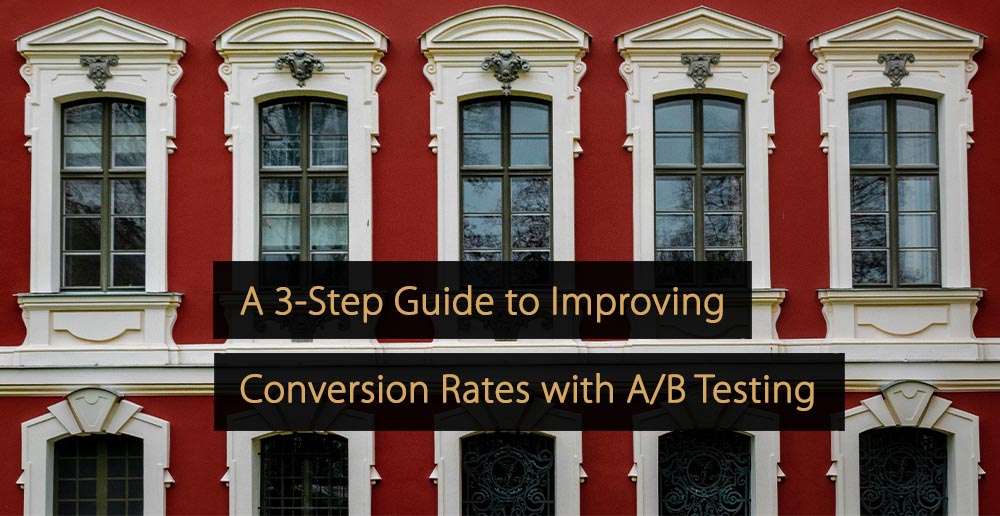
Want to turn more website visitors into hotel guests? A/B testing is your secret weapon! By comparing two versions of a page or message, you can find out what really clicks with your audience. For hotel websites, this means better user experience and more direct bookings. In this blog, we’ll cover everything from identifying the key elements to testing to setting up and running your tests and, finally, analyzing the results to keep those bookings rolling in. Ready to boost your conversion rates?
Improve Conversion Rates with A/B Testing in 3 Steps
Below, you will find a 3-step guide to improving conversion rates with A/B testing.
Step 1: Identify Key Elements to Test
If you feel that your website could use some help but you’re not sure where to start, data is your best friend. You don’t need a crystal ball to figure out what to A/B test. You simply need to learn to prioritize. Looking into your data is crucial to narrow down your efforts and focus on what truly matters for your hotel website.
Use analytics tools like Google Analytics to pinpoint high-traffic pages with low conversion rates. These pages are your goldmine for optimization opportunities. If your homepage attracts many visitors but few proceed to book a room, that’s a critical area to improve.
How to Use Analytics Tools
- Identify high-traffic pages: Check your analytics to see which pages have the most visitors.
- Analyse conversion rates: Focus on pages with high traffic but low conversion rates.
- Prioritise Elements: Within these pages, pinpoint the elements most likely to influence conversions—like headlines, images, CTAs, and layouts.
By targeting these high-impact areas, you can get the most out of your A/B tests. Plus, you’re likely to make significant improvements—no guesswork involved!
Choose High-Impact Elements
Now that you know where to focus, let’s talk about what to test. Here are some key elements that can significantly influence your conversion rates:
- Headlines: Your headlines are often the first thing visitors notice, and a strong headline can grab their attention and keep them on the page. You can test different headlines to see which ones are more engaging. For example, compare a straightforward “Book Now” with a more inviting “Reserve Your Room Today for Exclusive Benefits.”
- Images & media: The right images can speak volumes and influence your audience’s decision to book. Test various images—like photos of your rooms, amenities, or local attractions—to see which ones resonate best. Do remember to consider your target audience. Are they business travelers or holidaymakers? Match your images to their interests and needs.
- Calls to Action (CTAs): Your CTAs are crucial for driving conversions. Experiment with different phrases such as “Book Now,” “Check Availability,” or “Reserve Your Stay.” Also, play around with various colors and placements to see which combinations attract the most clicks. For example, a brightly colored “Book Now” button at the top of the page might perform better than a more subdued one at the bottom.
- Layouts: The overall layout of your page can make the difference between a book or a bounce. Test different layouts to see which ones provide a smoother user experience. Remember, what seems intuitive to you might not be the same for your guests.
Each of these elements—headlines, images, CTAs, and layouts—plays a critical role in shaping your visitors’ actions. By systematically testing and optimizing these areas, you can create a more engaging and effective website that turns visitors into guests.
Step 2: Conduct Your A/B Test
Now that you’ve identified the key elements to test, it’s time to dive into the A/B testing process itself. This step involves creating variations, setting up the test, monitoring it, and ensuring statistical significance.
Create Variations
First things first, develop two versions of the element you’re testing: the original (A) and a variation (B). Each version needs to be distinct enough to provide clear insights into what works best. Be bold with your changes—subtle tweaks might not provide clear results. Also, keep it simple by focusing on one element at a time.
For example, let’s say you’re testing headlines. Your original headline (A) might be “Book Your Stay Now,” while your variation (B) could be “Reserve Your Room Today and Save 20%.” The second headline offers a clear benefit, which might entice more visitors to book. However, this might not be the case in practice.
Set up the Test
Before setting up your test, it’s crucial to know exactly what you’re aiming for. Are you looking to increase bookings, or do you want users to take a specific action, like signing up for a newsletter? Be specific about your goals.
Use A/B testing tools like Google Optimize, Optimizely, or VWO to set up your test. If you’re testing different offers or packages, tools like Hotelchamp Convert can also help you set up A/B tests specifically for different promotions. These tools will help you randomly split your website traffic between the two versions, ensuring a fair comparison.
One handy tip is to calculate in advance what sample size you’re after. This is quite easy and can be driven by your existing page traffic. There are many tools out there that calculate your required sample size. Qualtrics provides an easy-to-use tool—and an explanation of what all the measures you’re looking at mean.
Monitor the Test
It’s crucial to run the test for an appropriate length of time to gather sufficient data. Avoid ending the test too early—this can lead to inconclusive results. Typically, a few weeks is a good duration, but this can vary based on your website traffic and the sample size you managed to collect. Of course, a larger sample size will give you more reliable data. If you don’t run the test long enough or have enough traffic, short-term variations might skew your results, leading to insignificant results or misleading conclusions.
Is Your Test Statistically Significant?
Before drawing any conclusions, make sure your test reaches statistical significance. This means the results should be reliable and not due to random chance. Most A/B testing tools will indicate when this threshold is met.
Statistical significance ensures that your results are not just random occurrences. Typically, a 95% confidence level is standard, meaning there’s only a 5% chance that the results are due to random factors. This confidence level ensures that you can be fairly certain your changes will positively impact your conversion rates.
You can use online tools to check for statistical significance or the sample size you need. For instance, AB Testguide’s Significance Calculator is a handy resource.
Step 3: Analyze Results and Implement Changes
With your A/B test complete, it’s time to dive into the results and make data-driven decisions to enhance your website.
Before drawing any conclusions, ensure your test reaches statistical significance. If not, your sample size might have been too small or the test period too short, which means the results aren’t reliable.
Assuming your A/B test went well, start by analyzing the results to determine which version performed better. Focus on key metrics such as conversion rate, bounce rate, and time on page. Visual aids like graphs or tables can help illustrate these metrics clearly. Remember to keep your original goal in mind, but keep an eye out for any additional learnings you might stumble upon.
Implement the Winning Variation
If the variation (B) outperforms the original (A), you can safely implement your changes. Monitor the impact post-implementation to ensure the positive changes continue. If the variation didn’t outperform the original, you’ve gained valuable insights into what doesn’t work, and you can test a new variation.
Next Steps
A/B testing is an ongoing process. Regularly test new elements and variations based on past learnings to continually optimize your website. By doing so, you ensure your website remains effective and engaging, leading to higher conversion rates and improved user experience.
A/B testing is a strategic approach to understanding what drives conversions on your hotel’s website. By identifying key elements to test, conducting thorough experiments, and analyzing the results, you can make data-driven decisions that enhance user experience and boost direct bookings. Keep iterating and refining your strategies to stay ahead in the competitive hotel industry. Happy testing!
Free Masterclass: Conversion Strategies for Direct Booking Success
This Conversion Masterclass puts you back in control of your hotel’s story. In just 1 hour across 8 expert-lead modules, we dive deep into the art and science of maximizing website conversion.
By offering unique and compelling reasons for guests to book directly, you’ll discover how to distinguish your hotel from the competition, securing direct bookings and driving success.
Click here to download the masterclass “Conversion Strategies for Direct Booking Success“.








